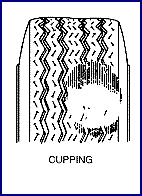WHAT IS RIDE CONTROL
Many things affect vehicles in motion. Weight, weight distribution, speed, road conditions, and wind are some of the factors that affect how a vehicle rolls down the highway.
Under all these variables, however, the vehicle’s suspension system – including the shocks, struts and springs – must be in good condition. Worn suspension components may reduce the stability of the vehicle and reduce passenger comfort. They may also accelerate wear on other suspension components, including the tyres.
For example, “cupping” is a tyre wear problem. “Cupping” (or small areas of heavy wear) is caused by the tyre bouncing as it rolls. This tyre wear pattern often indicates worn or damaged shocks or struts.
Tyre wear may also be caused by incorrect wheel alignment resulting from loose or worn suspension components. In fact, tyre wear can be a valuable diagnostic tool used to detect either defective suspension components or incorrect suspension alignment.
Likewise, vehicle sag can be another indicator of worn suspension components, in this case, the springs, as they are no longer able to support the weight of the vehicle at its specified design height. This may also affect the front-end alignment.
Replacing worn or inadequate shocks and struts helps maintain good ride control:
- Steering stability and control will be improved
- Wear on suspension components and tyres may be reduced by eliminating excessive bounce or vibration, and Improved riding comfort.

